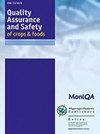不同家庭处理对甘蓝和小白菜中毒死蜱和氯氰菊酯的去除效果
IF 5.3
3区 农林科学
Q1 FOOD SCIENCE & TECHNOLOGY
引用次数: 16
摘要
在泰国民众中很受欢迎的甘蓝和小白菜等蔬菜被发现存在农药残留问题。甘蓝和小白菜的农药残留均为毒死蜱和氯氰菊酯。本试验研究了不同水洗工艺对甘蓝和小白菜样品农药残留的去除效果。过程包括用普通水、0.10% NaCl、小苏打、流水、焯水。采用气相色谱-火焰光度检测器(FPD)和气相色谱-电子捕获检测器(ECD)等分析工具对甘蓝和小白菜中农药残留的毒死磷和氯氰菊酯的残留量进行了测定。结果表明,家常水、0.10% NaCl、小苏打和流动水对甘蓝和小白菜中毒死蜱残留量的去除效果分别为52.70 ~ 65.41%、58.33 ~ 62.14%、59.46 ~ 80.52%和46.04 ~ 62.85%。同样,甘蓝和小白菜中氯氰菊酯残留量的家庭处理分别为:用普通水、10% NaCl、小苏打和流动水洗涤,分别减少51.13-66.29%、33.75-45.65%、38.14-63.64%和44.88-61.63%。漂烫可降低毒死蜱残留量37.96 ~ 50.44%,氯氰菊酯残留量47.86 ~ 52.42%。因此,在通过浸泡和溶解物质来洗涤蔬菜的同时,小苏打在洗涤时至少使用15分钟,以减少农药残留是最有效的。向消费者提供的蔬菜应经过清洗和适当清洗,以去除农药残留和有毒残留物。本文章由计算机程序翻译,如有差异,请以英文原文为准。
The efficiency of various household processing for removing chlorpyrifos and cypermethrin in Chinese kale and Pakchoi
The vegetables, Chinese kale and Pakchoi, which are popular among the Thai people, are found to have problems with residues of pesticide. The pesticide residues in both Kale and Pakchoi were chlorpyrifos and cypermethrin. This research was to study the efficiency of pesticide residue reduction in Chinese kale and Pakchoi samples by using various household wash processing. The process included washing with normal water, 0.10% NaCl, baking soda, water flowing, and blanching. Pesticide residues were extracted from Chinese kale and Pakchoi to determine the amount of chlorpyriphos and cypermethrin residue by using analytical tools such as Gas Chromatography— Flame Photometric Detector (FPD) and Gas Chromatography—Electron Capture Detector (ECD). The results showed that the household processes for reducing the chlorpyrifos residue in Chinese kale and Pakchoi were the following: residues were reduced by 52.70–65.41%, 58.33–62.14%, 59.46–80.52%, and 46.04–62.85% when washed with normal water, 0.10% NaCl, baking soda, and water flowing through, respectively. Similarly, the household processes for reducing cypermethrin residue in Chinese kale and Pakchoi were the following: residues were reduced by 51.13–66.29%, 33.75–45.65%, 38.14–63.64%, and 44.88–61.63% when washed with normal water, 10% NaCl, baking soda, and water flowing through, respectively. Also, blanching reduced the chlorpyrifos residue by 37.96–50.44% and the cypermethrin residue by 47.86–52.42%. Therefore, while washing vegetables by soaking and dissolving substances, baking soda is the most effective when used for washing for at least 15 min to reduce the residue of pesticides. The consumers should be provided vegetables that are cleaned and have had a proper washing for removing pesticide residues and toxic residues.
求助全文
通过发布文献求助,成功后即可免费获取论文全文。
去求助
来源期刊

Quality Assurance and Safety of Crops & Foods
FOOD SCIENCE & TECHNOLOGY-
CiteScore
4.60
自引率
7.50%
发文量
61
审稿时长
1 months
期刊介绍:
''Quality Assurance and Safety of Crops & Foods'' is an international peer-reviewed journal publishing research and review papers associated with the quality and safety of food and food sources including cereals, grains, oilseeds, fruits, root crops and animal sources. It targets both primary materials and their conversion to human foods. There is a strong focus on the development and application of new analytical tools and their potential for quality assessment, assurance, control and safety. The scope includes issues of risk assessment, traceability, authenticity, food security and socio-economic impacts. Manuscripts presenting novel data and information that are likely to significantly contribute to scientific knowledge in areas of food quality and safety will be considered.
''Quality Assurance and Safety of Crops & Foods'' provides a forum for all those working in the specialist field of food quality and safety to report on the progress and outcomes of their research.
 求助内容:
求助内容: 应助结果提醒方式:
应助结果提醒方式:


